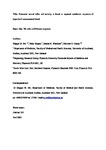Enhanced natural killer cell activity is found in exposed uninfected recipients of hepatitis C-contaminated blood
| dc.contributor.author | Ow, MM | |
| dc.contributor.author | Hegazy, D | |
| dc.contributor.author | Warshow, UM | |
| dc.contributor.author | Cramp, Matthew | |
| dc.date.accessioned | 2019-01-24T16:33:16Z | |
| dc.date.available | 2019-01-24T16:33:16Z | |
| dc.date.issued | 2018-03 | |
| dc.identifier.issn | 1352-0504 | |
| dc.identifier.issn | 1365-2893 | |
| dc.identifier.uri | http://hdl.handle.net/10026.1/13221 | |
| dc.description.abstract |
<jats:title>Summary</jats:title><jats:p>A minority of injecting drug users, termed exposed uninfected, are resistant to hepatitis C (<jats:styled-content style="fixed-case">HCV</jats:styled-content>) infection despite repeated low‐dose exposures. We identify for the first time a cohort of blood recipients who remained uninfected despite large‐dose exposure to <jats:styled-content style="fixed-case">HCV</jats:styled-content>‐contaminated blood and characterize immune factors that may confer protection. Of 1340 blood recipients from the English Look Back database who were transfused <jats:styled-content style="fixed-case">HCV</jats:styled-content>‐contaminated blood, we identified 8 who remained uninfected. In these 8 exposed uninfecteds, we characterized their natural killer (<jats:styled-content style="fixed-case">NK</jats:styled-content>) cell populations and <jats:styled-content style="fixed-case">HCV</jats:styled-content>‐specific T‐cell responses. Findings were compared with 10 spontaneous resolvers of <jats:styled-content style="fixed-case">HCV</jats:styled-content> infection, 10 patients with chronic <jats:styled-content style="fixed-case">HCV</jats:styled-content> infection and 10 healthy controls. Exposed uninfecteds had significantly greater numbers of <jats:styled-content style="fixed-case">NK</jats:styled-content> cells with the activating receptor <jats:styled-content style="fixed-case">NK</jats:styled-content>p30+ on <jats:styled-content style="fixed-case">CD</jats:styled-content>56<jats:sup>bright</jats:sup> and <jats:styled-content style="fixed-case">CD</jats:styled-content>56<jats:sup>dim</jats:sup> subsets compared with other groups (<jats:italic>P</jats:italic> < .05). Following interleukin‐2 activation, <jats:styled-content style="fixed-case">NK</jats:styled-content> cells of exposed uninfecteds had enhanced cytotoxicity that positively correlated with <jats:styled-content style="fixed-case">NK</jats:styled-content>p30 expression (<jats:italic>P</jats:italic> = .02). Differences in <jats:styled-content style="fixed-case">NK</jats:styled-content>p80 and <jats:styled-content style="fixed-case">KIR</jats:styled-content>2<jats:styled-content style="fixed-case">DL</jats:styled-content>3 expression were also observed. <jats:styled-content style="fixed-case">HCV</jats:styled-content>‐specific T‐cell responses were observed in some exposed uninfecteds but of low amplitude. Exposure without infection following transfusion of <jats:styled-content style="fixed-case">HCV</jats:styled-content>‐contaminated blood is a very rare phenomenon and suggests a high level of resistance to infection. Enhanced <jats:styled-content style="fixed-case">NK</jats:styled-content> cell activation and killing, with weak <jats:styled-content style="fixed-case">HCV</jats:styled-content>‐specific T‐cell responses, were observed many years after exposure in uninfected recipients and may contribute to protection from <jats:styled-content style="fixed-case">HCV</jats:styled-content> acquisition, although additional protective factors are being sought in this important cohort.</jats:p> | |
| dc.format.extent | 245-253 | |
| dc.format.medium | Print-Electronic | |
| dc.language | en | |
| dc.language.iso | en | |
| dc.publisher | Wiley | |
| dc.subject | exposed uninfected | |
| dc.subject | Hepatitis C | |
| dc.subject | innate immunity | |
| dc.subject | natural killer cells | |
| dc.subject | NKp30 | |
| dc.title | Enhanced natural killer cell activity is found in exposed uninfected recipients of hepatitis C-contaminated blood | |
| dc.type | journal-article | |
| dc.type | Journal Article | |
| dc.type | Research Support, Non-U.S. Gov't | |
| plymouth.author-url | https://www.webofscience.com/api/gateway?GWVersion=2&SrcApp=PARTNER_APP&SrcAuth=LinksAMR&KeyUT=WOS:000426516000004&DestLinkType=FullRecord&DestApp=ALL_WOS&UsrCustomerID=11bb513d99f797142bcfeffcc58ea008 | |
| plymouth.issue | 3 | |
| plymouth.volume | 25 | |
| plymouth.publication-status | Published | |
| plymouth.journal | Journal of Viral Hepatitis | |
| dc.identifier.doi | 10.1111/jvh.12810 | |
| plymouth.organisational-group | /Plymouth | |
| plymouth.organisational-group | /Plymouth/Faculty of Health | |
| plymouth.organisational-group | /Plymouth/Faculty of Health/Peninsula Medical School | |
| plymouth.organisational-group | /Plymouth/REF 2021 Researchers by UoA | |
| plymouth.organisational-group | /Plymouth/REF 2021 Researchers by UoA/UoA01 Clinical Medicine | |
| plymouth.organisational-group | /Plymouth/Research Groups | |
| plymouth.organisational-group | /Plymouth/Research Groups/Institute of Translational and Stratified Medicine (ITSMED) | |
| plymouth.organisational-group | /Plymouth/Research Groups/Institute of Translational and Stratified Medicine (ITSMED)/CBR | |
| plymouth.organisational-group | /Plymouth/Users by role | |
| plymouth.organisational-group | /Plymouth/Users by role/Academics | |
| dc.publisher.place | England | |
| dcterms.dateAccepted | 2017-09-04 | |
| dc.identifier.eissn | 1365-2893 | |
| dc.rights.embargoperiod | Not known | |
| rioxxterms.versionofrecord | 10.1111/jvh.12810 | |
| rioxxterms.licenseref.uri | http://www.rioxx.net/licenses/all-rights-reserved | |
| rioxxterms.licenseref.startdate | 2018-03 | |
| rioxxterms.type | Journal Article/Review |


